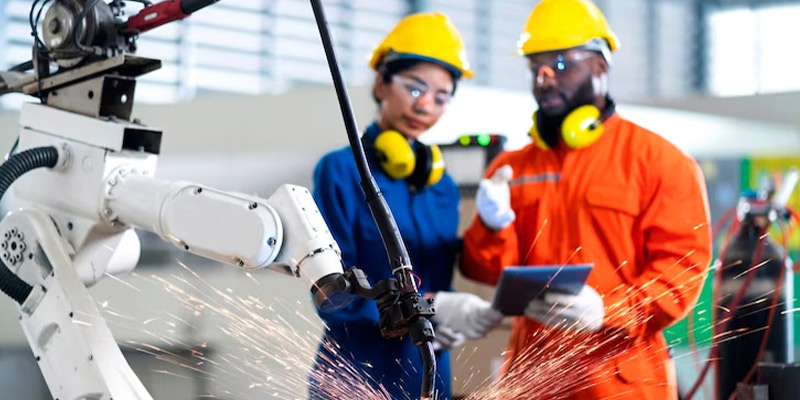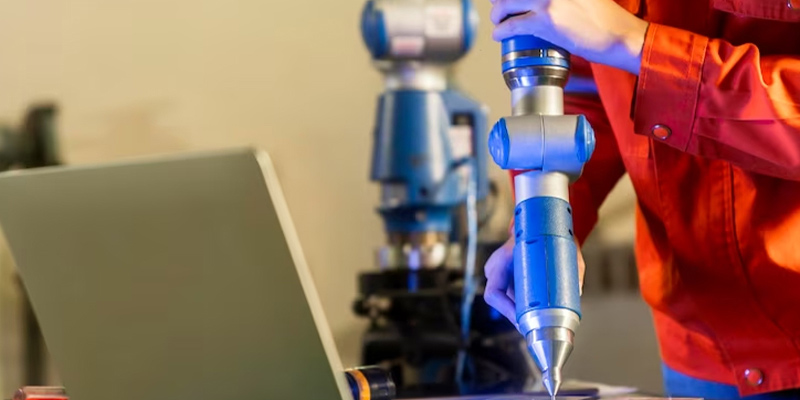Overview
Rising demand for lightweight ancillaries in automotive and defense sectors coupled with the shifting inclination towards the use of manufacturing complex designs with short production cycle times are expected to play a key role in expanding the market reach of additive manufacturing on a global level. Furthermore, the growing importance of inducing a reduction of the total cost of ownership (TCO) in the manufacturing sector. With the increasing use of additive manufacturing globally, major companies are expanding their production capacities in different countries to strengthen their presence for these products in the market.
The advantages offered by additive manufacturing in various buyer segments, easy customization, and bulk production using additive manufacturing are projected to open new market avenues. Technological upgradation in the healthcare sector coupled with supportive government funding to promote additive manufacturing are expected to keep the market bullish for the key industry participants. However, Issues related to material availability, elopement, validation, and standardization are projected to challenge the market growth.
What is Additive Manufacturing?

Additive manufacturing (AM) is different from the subtractive method of production, which envisages grinding out unnecessary material from a block of material. The use of additive manufacturing in industrial applications usually refers to 3D printing. It involves a layer-by-layer accumulation of material to form an object while referring to a three-dimensional file with the help of a 3D printing equipment and software. A suitable additive manufacturing technology is selected from the available set of technologies depending upon the application.
Application Scenario

With the development of new vehicles, there is an increasing demand from customers, along with a rise in demand for design and comfort. Various safety measures and regulations imposed by various governments have increased the weight of automotive and aerospace components. Therefore, with the increase in weight, there will be a high consumption of fuel for proper functionality. Thus, to meet the demand and compensate for the fuel efficiency, the design and product must be complex and lightweight in structure. This can be achieved through the potential of additive manufacturing technologies like Fiber-reinforced additive manufacturing (FRAM). For instance, a chassis of a racing car is generatively designed and manufactured using FRAM with a matrix of short fibers and long fibers reinforced with carbon fiber, which is lightweight as compared to the metal chassis. This helps in regulating the aerodynamics of the car, which helps in speeding up and lowering fuel consumption.
To achieve the target of having lightweight vehicles and other automobile and aerospace components, various additive manufacturing industries have developed certain technologies and materials that are constantly coming to the market. One example of such development is the combination of material extrusion (MEX) in the form of fused layer modeling (FLM) of plastic filaments with reinforcement of short and long fibers.
Moreover, the aerospace sector requires numerous interacting technical and economic objectives of functional performance, which lead to time reduction, weight weightiness of flights, cost management, and delivering safety-critical components. Additive manufacturing technologies, unlike conventional traditional manufacturing, use layer-by-layer manufacturing based on typical powder or wire and materials such as plastic polymer, which is of lighter weight that allows for achieving the lightweight nature of flight carriers' engines and components.
Additive manufacturing has significantly increased the speed of the design process. At the same time, traditional manufacturing can take up to several months to produce the necessary tools required to create end parts and prototypes. The automobile and aerospace industry has found additive manufacturing advantageous in avoiding costly and time-consuming tooling.
The aerospace industry has also found 3D printing to produce freeform, optimized objects, which means that the weight of a part can be effectively reduced using additive manufacturing, thus saving material costs and production time. By using advanced design tools, engineers have reduced the number of components used in traditional processes to just one by using additive manufacturing, thus greatly simplifying the assembly process of complex designs.
Furthermore, technologies such as Wire Arc Additive Manufacturing (WAAM) and Direct Energy Deposition (DED) are widely used to repair functional military equipment in defense sectors. These technologies help to restore and repair worn surfaces of turbine blades and high-end equipment. Though replacement parts can run out of stock, 3D scanning techniques are really helpful to reverse engineer an available part, which can be easily replicated using 3D printing.
Any industry can benefit from lightweight parts and components as it reduces material cost and energy consumption. However, using lightweight parts in the automotive sector in manufacturing vehicles is crucial. In addition, electric vehicles generally do not reach the same peak speeds as combustion engines. Making electric vehicles lighter is expected to improve the engine's efficiency, and it can help bridge the gap between the two vehicle types.
USP of Additive Manufacturing
Additive manufacturing has proven to be a powerful technology revolutionizing production processes across various end-user industries. Additive manufacturing technologies have been practical and reliable and have been efficiently used over the last few years. Additive manufacturing technologies via 3D printer allow companies to get instant tools of requirement without depending on another supplier since 3D printer allows them to design and customize parts instantly without the need for cumbersome tools or mold revisions. This also helps in reducing the shipping cost and also saves time when needed spare parts for renovation like in racing cars.
Industries such as aerospace and defense are some of the other industries that use additive manufacturing products for their performance. Aircraft parts are used by additive manufacturing products that are lightweight and can withstand harsh environmental conditions. Due to less material required and the process of forming materials layers by layers, aerospace industries utilize it as the advantage for weight reduction and waste reduction, which are very important for the manufacturing of aerospace parts for major companies.
In addition, with rapid advancement and innovation in medical industries, the utilization of additive manufacturing products is of great advantage for doctors, patients, and research institutions. Through functional prototype design provided by additive manufacturing technologies, it has been of great advantage to create a flexible design of various design life-saving tools needed for surgical and study purposes, tools used in the dental procedure, pre-surgery models for CT scans, custom saw and drill guides, enclosures, and specialized instrumentation.
Apart from this, various other industries are dependent on additive manufacturing technologies for quick and customizable designs provided by 3D printers. Additive manufacturing technologies speed up production and cope with the demand for different design products required in different shapes and designs with realism and functionality. Some of the end users are electronic manufacturing companies and architecture model designers, among many others.
Ease of customization has been prompting buyers to increase spending on additive manufacturing
With companies manufacturing standardized and generic products with the same design and pattern as in mass production, there is a demand for customized products where each customer is a different individual with their personal design or product used to preference.
Additive manufacturing allows customization, unlike traditional manufacturing, at no additional cost and does not require additional mold or tools for the designing process. It just needs a prototype 3D design and can be created by the customer itself. Owing to the ease of customization and fast production, there is high demand for additive manufacturing. Moreover, the use of AM (Additive Manufacturing) technologies can give consumers a unique buyer and consumer experience where it gives them a feeling of belongingness and consumer satisfaction as compared to the counterpart, which does not provide personalization.
For instances, the Germany-based automotive manufacturer named, BMW has allowed customers in their BMW MINI series where customer can customize their design through the company's online shop on some specific parts like the door handle or parts of the side plates. On the other hand, the earphone- company NORMAL has paved the way for customers to design their earphones by designing according to the client's creativity by downloading their apps, and the customers will be delivered with their own customized earbuds
The conventional component manufacturing processes depend on using high-capacity resources combined with control elements to get extremely high levels of precision. However, traditional manufacturing processes cannot beat the advantages of using additive manufacturing processes. Furthermore, additive manufacturing can build complicated designs that would be quite difficult to achieve using traditional manufacturing processes. The functionality and precision of additive manufacturing are much higher than traditional manufacturing processes. Production times can be shortened in additive manufacturing from weeks to days, unlike conventional manufacturing methods. Additive manufacturing machines can print continuously, and it requires minimal supervision. This allows the manufacturer to operate on a "just-in-time" principle by producing the needed amount and avoiding wasting money and storage space on excess inventory.
Moreover, the varied processes available in additive manufacturing provides various production advantage over conventional manufacturing processes. Therefore, the ease of manufacturing complex and customized designs with a short production cycle is expected to drive the global additive manufacturing market.
Burning Issues: At a Glance
The high cost of equipment and the limited access to professionals in additive manufacturing are expected to be some of the factors which are likely to limit the scope of additive manufacturing technology over the next few years. Additive manufacturing equipment falls under the cost in the range of USD 300,000 to USD 1.5 million. Furthermore, the industrial consumables fall under the price range of USD 100 to USD 150 per piece. As a result, the labor-intensive manufacturing companies are likely to refrain to use such manufacturing technologies for their in-house production.
Additive manufacturing is considered a savior in complex design production. But it still has a certain limitation that further hinders its market growth. Additive manufacturing is considered ideal for making prototypes and complex parts or designs, but it is still complicated to manufacture large single parts.
Additive manufacturing utilizes the laser powder-bed fusion (PBF) process can build complex and intricate shapes along with organic structures. These forms were considered too expensive or complex for manufacturing by the use of traditional manufacturing operations. For instance, laser PBF could be utilized for the production of lightweight components for ensuring the most intricate lattice structures to induce efficient material usage.
Positive Outlook Towards Healthcare Sector
The development of digitalizing medical imaging and this digitalization allows for the reconstruction of 3D models from patients' anatomy. The typical workflow of the personalized medical device starts with imaging or capturing the patient’s geometry of the anatomy using computed 3D scanning methods. Such data can be utilized to print 3D models of a patient’s anatomy or can be used to create personalized devices or implants.
There are various medical applications of additive manufacturing in the medical sector, which include medical models, implants, tools, instruments, and parts for medical devices, medical aids, supportive guides, splints and prostheses, and bio-manufacturing, among many others. For instance, the medical models are based on patients' anatomy, and they are used for pre-and postoperative, operative planning and training medical students and informing patients and patient's families. The models can be taken for a specific interesting section. Medical models are widely used for the craniomaxillofacial area, limbs, pelvic, and other bones structure. These medical models are made through prototype design in a 3D printer where the workflow of the design and dimension are obtained through X-rays, CT scans and MRI, and many other scanning methods.
“Standalone” segment dominated the market due to the availability of technologically advanced standalone 3D printing devices, as well as increased research and development by key market players in preparation for the release of advanced standalone systems. Data Bridge Market Research analyses that the healthcare 3D printing market is expected to grow at a CAGR of 22.8% during the forecast period of 2022 to 2029.
To know more about the study, visit https://www.databridgemarketresearch.com/reports/global-healthcare-3d-printing-market
On the other hand, implants are directly and indirectly additively manufactured to replace defective or missing tissues, and this also includes dental applications such as crowns and bridges. The material should be compatible with tissues. Additive manufacturing is a favorable solution similar to the medical model. Through additive manufacturing technologies, we can have a customize and personalized implant through digital 3D printing, which is patient-specific fittings
Data Bridge Market Research analyses the market is expected to grow at a CAGR of 4.21% in the above-mentioned forecast period. The increasing prevalence of epilepsy, cardiac disorders, and Parkinson’s disease is the vital factor driving the microelectronic medical implants market.
https://www.databridgemarketresearch.com/reports/global-microelectronic-medical-implants-market
Government Spending is Expected to Upscale the Market Movement
Additive manufacturing is considered as one of the potential categories where the companies are revolutionizing the manufacturing and industrial production landscape through digital processes, communication, and imaging. Having seen the potential with the possibility of this sector its contribution to the various nation economy, governments of different countries are coming up with different strategies to support and promote additive manufacturing in various sectors.
For instance, the government of China, the U.S., and Russia have bolstered user-confident in advanced technologies through the adoption and development of an application for military force. For instance, the additive manufacturing unit of the Marine Corps has created the largest 3D concrete printer capable of printing 500 square-foot barracks hut in just 40 hours. On the other hand, The U.S. department of Commerce’s National Institute of Standards and Technology (NIST) has awarded USD 3.7 million in grants to help address current and future barriers to the widespread adoption of metals-based additive manufacturing through measurement scientific research
Conclusion
Additive manufacturing has been emerged as one of the key tool which not only save the total cost of ownership of manufacturing companies but also result in enhancing the structural features of components. The positive outlook towards manufacturing sector of developing countries including China and India coupled with strong R&D spending in automotive, aerospace, and healthcare sectors is expected to keep the finger crossed for the industry participants operating across the value chain of additive manufacturing, However, the additive manufacturing companies are expected to increase spending on reduce the cost of delivering their preposition to their customers along with extending their buyers’ base to increase the finished products’ or offerings’ awareness in the near future.
Data Bridge Market Research analyses that the market is growing with a CAGR of 20.9% in the forecast period of 2023 to 2030 and is expected to reach USD 91,853.88 million by 2030. The major factor driving the growth of the additive manufacturing market is the increasing demand for lightweight components from the automotive and aerospace industries.
To know more about the study, https://www.databridgemarketresearch.com/reports/global-additive-manufacturing-market




